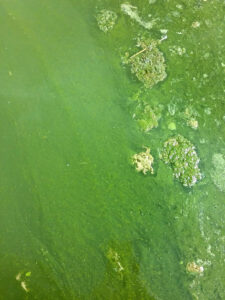
Algae blooms that grow in the surfaces of some lakes and rivers are not only gross to look at, they can be toxic.
In 2014, two dogs swimming in Utah Lake died from exposure to the toxic algae, and another dog died from it in 2020 in the Virgin River in Zion’s National Park. The phenomenon was also to blame for the deaths of 15 calves and three adult cows in 2004 after they drank water from Matt Warner Reservoir in eastern Utah.
University of Utah civil and environmental engineering professor Ramesh Goel, (pictured, below) who has been studying algae blooms at Utah Lake and other bodies of water in the state, has just received a $3 million grant from the National Science Foundation to explore on a genetic level why some algae blooms are poisonous and others are not.
“We’re looking into the genotypes of why some generate toxins and others don’t, even though they belong to the same genus,” Goel says. “Classical ecological monitoring is not sufficient to pinpoint this, so what we are doing has never been done at this level.”
 Algae blooms contain cyanobacteria, also known as “blue-green algae,” microscopic organisms that use carbon dioxide gas or inorganic carbon and light to multiply. But their growth also depends on the availability of nitrogen and phosphorous, which act as nutrients. The excess of these nutrients that drive algae blooms usually comes from man-made sources such as fertilizers from farming and nearby homes and from urban runoff such as storm drainage. Because the algae are buoyant, they can move up and down a water column and spread.
Algae blooms contain cyanobacteria, also known as “blue-green algae,” microscopic organisms that use carbon dioxide gas or inorganic carbon and light to multiply. But their growth also depends on the availability of nitrogen and phosphorous, which act as nutrients. The excess of these nutrients that drive algae blooms usually comes from man-made sources such as fertilizers from farming and nearby homes and from urban runoff such as storm drainage. Because the algae are buoyant, they can move up and down a water column and spread.
Goel and his team will be using DNA and RNA sequencing and bioinformatics (analyzing biological data) to better understand what makes the algae grow and how environmental factors such as temperature and sunlight affect its ability to take in nutrients in the water. They will be studying algae in Utah Lake and in streams and rivers in Zion National Park and near the California-Nevada border.
Goel has already learned that climate change is an important factor in the growth of this algae, he said. Longer summers and shorter springs due to climate change allow the algae blooms to start earlier in the year, last longer and therefore become more toxic by the end of the summer.
Not only has the algae killed animals and made some people sick, but it’s also damaging to the bodies of water it grows in, Goel says.
“They generate a lot of biomass, which decays and eventually settles down and causes damage to oxygen levels, which in turn can negatively affect the aquatic life,” he says.
Better understanding on a genetic level how this algae flourishes under different environment conditions can lead to predictive models that can help water management and other environmental officials. “These models based on experimental data will enable us to forecast the extent and duration of the blooms,” Goel says. “And water professionals and health managers can make better, earlier decisions.”